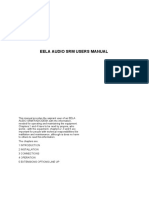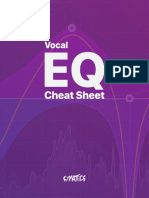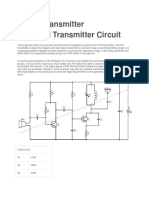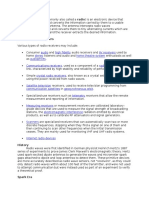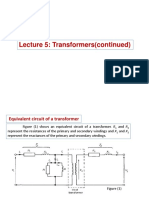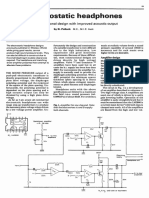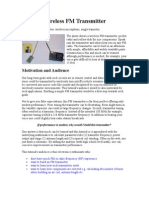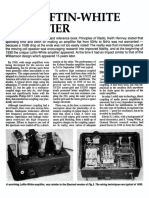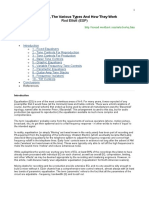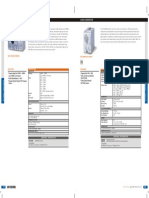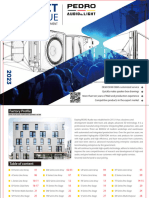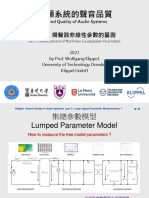Expandable Graphic Equaliser
Expandable Graphic Equaliser
Uploaded by
Carlos TigseCopyright:
Available Formats
Expandable Graphic Equaliser
Expandable Graphic Equaliser
Uploaded by
Carlos TigseCopyright
Available Formats
Share this document
Did you find this document useful?
Is this content inappropriate?
Copyright:
Available Formats
Expandable Graphic Equaliser
Expandable Graphic Equaliser
Uploaded by
Carlos TigseCopyright:
Available Formats
Expandable Graphic Equaliser
Rod Elliott (ESP) [1]
More Sharing ServicesShare|Share on facebookShare on myspaceShare on googleShare on twitter Introduction The project described in this article is a constant Q, fully expandable graphic equaliser. Where most "conventional" graphic EQ circuits have a Q that is dependent on the setting of the pot, this one maintains the same Q at all settings. This is achieved by using MFB (Multiple Feedback Bandpass) filters, instead of the more common "gyrator" tuned circuit. As always, there are pros and cons for the approach described here. Phase shifts tend to be a little more radical, and the passband has more ripple than a conventional circuit, but only where a number of sliders are set to boost or cut. On the positive side, specific frequencies are dealt with specifically regardless of the level, and not with a variable Q. The constant Q circuit makes room equalisation and feedback reduction far better behaved. So much better in fact, that a boost or cut of 3dB or less may provide the required effect, where a variable Q equaliser may need considerably more, and will affect the adjacent frequencies to a far greater degree.
Description The filters used are the same as in the Instrument Graphic Equaliser and subwoofer equaliser (see Project 64 and Project 84), and are multiple feedback bandpass types. An example of this filter is shown in Figure 1, and more details are available from the project page for the MFB filter (Project 63). Depending on the configuration you ultimately decide upon, you will need between 10 and 30 of these filters - per channel for stereo!
Figure 1 - Basic Multiple Feedback Bandpass Filter
This circuit is reproduced from the original article for convenience - the actual filter circuits used are slightly different, and are shown in Figure 3. Building 60 of these may sound like an awful chore, which is perfectly reasonable, since it will be just that. With this knowledge at hand, this may go some way to help you make some ... Decisions! Now you have to decide on the frequency resolution. 1/3 octave would be really nice, but the number of sliders can be a nightmare. At the very least, you will need octave band, and the suggested (and industry standard) frequencies are ...
31 63 125 250 500 1k0 2k0 4k0 8k0 16k Octave Band Frequencies 31 44 63 87 125 175 250 350 500 700 1k0 1k4 2k0 2k8 4k0 5k6 8k0 11k 16k 20k 1/2 Octave Band Frequencies 31 40 50 63 80 100 125 160 200 250 315 400 500 630 800 1k0 1k2 1k6 2k0 2k5 3k2 4k0 5k0 6k3 8k0 10k 12k 16k 1/3 Octave Band Frequencies 31 40 50 63 80 100 125 160 200 250 315 400 500 630 800 1k0 1k4 2k0 2k8 4k0 5k6 8k0 16k Variable Octave Band Frequencies Freq R1 R2 R3 C1, C2 Freq R1 R2 R3 C1, C2 31 82k 2k7 160k 220nF 500 27k 820 56k 47nF 40 82k 2k7 160k 180nF 630 27k 820 56k 39nF 50 82k 2k7 160k 150nF 800 27k 820 56k 27nF+2n7 63 82k 2k7 160k 120nF 1k0 8k2 510 18k 47nF+4n7 80 82k 2k7 160k 100nF 1k4 8k2 510 18k 39nF 100 82k 2k7 160k 82nF 2k0 8k2 510 18k 27nF 125 82k 2k7 160k 56nF+5n6 2k8 8k2 510 18k 18nF+1n5 160 82k 2k7 160k 47nF 4k0 8k2 510 18k 12nF+1n8
200 250 315 400
82k 2k7 160k 39nF 5k6 8k2 750 18k 8n2 82k 2k7 160k 27nF+4n7 8k0 8k2 1k2 18k 4n7 82k 2k7 160k 22nF+2n7 16k 8k2 1k2 18k 2n2 82k 2k7 160k 18nF+1n5 Frequency & Component Values
Input / Output Stage The heart of the circuit is shown in Figure 2. It is not complex, but care is needed to make sure that the opamps do not oscillate. Supply bypassing is critical, and 100nF ceramic caps must be used between supply pins at each opamp package.
Figure 2 - Input / Output Stage
There is one thing of special note in this circuit. R6 (39k as shown) determines the maximum amount of boost and cut, and if you wanted to, you can make it variable. With the filter circuits shown below, 39k allows a boost and cut of 12dB - which is about right in most installations. A value of 10k will allow a maximum of a little over 5dB. Any value between these limits will provide the optimum for a given environment, and this can be preset. This is a very useful feature, and one that I believe is unique to this circuit.
Filters
Determining the required Q is the first step in the design process. The requirements are shown in the following table. The gain in each case is unity (actually -1, meaning a gain of unity, but the signal is inverted, or 180 degrees out of phase). Bandwidth 1/3 octave 1/2 octave 1 octave Required Q 4 3 2
The filters are all connected in the same way, and I do not intend to draw all 30 of them! Instead, I shall show two complete and two partial filters - you will be able to take it from there. The tables above, and/ or the MFB calculator program can be used to determine the values for each individual filter.
Figure 3 - The Filter Bank (Partial Only)
The slide pots are wired with all the end connections in parallel, and the "Sig" output above must drive all the filter inputs, which are also in parallel. For a 1/3
octave equaliser, this represents a load of around 800 ohms on U2B. The NE5532 was chosen as it is one of the few opamps that will drive such a low impedance. Don't be tempted to use anything that is not rated to drive such a low impedance, or it will distort because of output current limiting. Another suitable opamp is the OPA2134 (dual), which also has a very high drive capability - there are no doubt others, but these are the ones I know about. The maximum rated input voltage is 1V (0dBu), and if you anticipate that the input will be higher than that, I suggest an attenuator at the input. The gain can be restored by increasing the value of R8, so if a 3:1 attenuator were used at the input (10dB), then a 30k (33k would be OK) resistor in place of the 10k will bring the overall gain back to unity. Remember that U2B operates with gain (about 12dB), so the internal overload limit is lower than you might expect. Because of the narrow bandwidth of each filter, these too can be driven into clipping if the input level is too high, and this is unlikely to improve the sound. Overall, this is a very versatile unit, and once the initial shock of construction has passed, can be used for the most demanding of equalisation tasks. It can also be used in an automotive installation, but an artificial earth must be created, and the signal voltage limits will be reduced considerably. I suggest that the maximum input voltage be kept below 0.5V RMS - lower than this will provide a better safety margin, and will ensure that clipping does not occur regardless of slider settings.
Figure 4 - Frequency Response of a Single Filter
Figure 4 shows the boost and cut of a single filter, centred on 100Hz. This clearly shows that the Q remains constant - a conventional graphic EQ would have a very broad peak at lower settings, so broad in fact that it would show some noticeable effect even at several octaves away from the centre frequency. Assuming that the
50% pot setting is flat, these graphs were taken at 35/65%, and 0/100% of the pot travel (cut/boost respectively). This was generated using a 39k resistor for R6 in the input circuit - lower values reduce the maximum boost and cut, but leave the Q unchanged.
You might also like
- Eela Audio SRM Users ManualDocument14 pagesEela Audio SRM Users ManualJose Carlos SoaresNo ratings yet
- JAT501 DesignDocument5 pagesJAT501 DesignIvanNo ratings yet
- FM Crystal RadioDocument11 pagesFM Crystal RadioSuhendri Saputra100% (1)
- Tetra Sans PS - Glassware / Tubecad - by John BroskieDocument17 pagesTetra Sans PS - Glassware / Tubecad - by John BroskieRafael Frederico TeixeiraNo ratings yet
- LEAK Stereo 30Document6 pagesLEAK Stereo 30BunyippyNo ratings yet
- FM Radio ReceiverDocument7 pagesFM Radio Receivermeet_kaur865959100% (1)
- Vocal EQ Cheat Sheet PDFDocument11 pagesVocal EQ Cheat Sheet PDFShubham Yelekar80% (5)
- FM Radio ReceiverDocument3 pagesFM Radio ReceiverRajatNo ratings yet
- 3V FM Transmitter 3V FM Transmitter CircuitDocument4 pages3V FM Transmitter 3V FM Transmitter Circuitpeter.gomes20087216No ratings yet
- Small Radio Transmitter CircuitDocument2 pagesSmall Radio Transmitter Circuitrik206No ratings yet
- MInitransceiver SSB 80mDocument8 pagesMInitransceiver SSB 80mag1tatorNo ratings yet
- FM TransmitterDocument15 pagesFM TransmitterMuhammad Aiman AmranNo ratings yet
- Pink Noise Generator For Audio TestingDocument3 pagesPink Noise Generator For Audio Testingmmd3100% (1)
- 45-860MHz Radio Receiver Based On UV916-tunerDocument7 pages45-860MHz Radio Receiver Based On UV916-tunerSutharsan Kumar Krishnamoorthy100% (1)
- Radio Transmitter: Gomez Abegail Hayag Frank CarloDocument16 pagesRadio Transmitter: Gomez Abegail Hayag Frank Carlofrank1carloNo ratings yet
- Radio ReceiverDocument7 pagesRadio ReceiverMarimar BizNo ratings yet
- User Guide: Constant-Current-Draw AmplifierDocument20 pagesUser Guide: Constant-Current-Draw AmplifierHuythuong NguyenNo ratings yet
- HHODocument5 pagesHHOdan_todoran100% (1)
- Audio Transformer InductanceDocument8 pagesAudio Transformer InductanceCharles AustinNo ratings yet
- Lecture 5: Transformers (Continued)Document16 pagesLecture 5: Transformers (Continued)Aldiansyah dtsNo ratings yet
- 200M FM Transmitter - Electronic Circuits and Diagrams-Electronic Projects and Design PDFDocument1 page200M FM Transmitter - Electronic Circuits and Diagrams-Electronic Projects and Design PDFZersh EthioNo ratings yet
- Simple Autorange Capacitor Tester / Capacitance Meter With Arduino and by HandDocument7 pagesSimple Autorange Capacitor Tester / Capacitance Meter With Arduino and by HandOussama LabsailiNo ratings yet
- A Simple Way To Test Capacitors PDFDocument7 pagesA Simple Way To Test Capacitors PDFmilan_lahiru100% (1)
- Post PI Master VolumeDocument1 pagePost PI Master VolumeFrank L. BaumNo ratings yet
- How To Wind Your Own Audio TransformerDocument8 pagesHow To Wind Your Own Audio TransformerOscar Pacheco100% (1)
- Electrostatic Headphones - N. Pollock (Wireless World, Nov 1979)Document5 pagesElectrostatic Headphones - N. Pollock (Wireless World, Nov 1979)jimmy67musicNo ratings yet
- PS 3 PDFDocument22 pagesPS 3 PDFDragoslav IvankovicNo ratings yet
- Substiution of Electron Tubes by Semiconductor ReplacementsDocument10 pagesSubstiution of Electron Tubes by Semiconductor ReplacementsJames BellNo ratings yet
- Valve (Tube) Regulated Power Supplies (AudioXpress 2008)Document6 pagesValve (Tube) Regulated Power Supplies (AudioXpress 2008)Kemboya LuigiNo ratings yet
- Tube Terminology For DummiesDocument5 pagesTube Terminology For DummiesLauraWatsonNo ratings yet
- Watts Tube Audio - Capacitor Code ChartDocument3 pagesWatts Tube Audio - Capacitor Code ChartMiguel GoffredoNo ratings yet
- CircuitryDocument1,604 pagesCircuitrygakintola79No ratings yet
- Wireless FM TransmitterDocument11 pagesWireless FM Transmitteranon-73153100% (4)
- Physics Lab Manual Final1 03.11.08 PDFDocument50 pagesPhysics Lab Manual Final1 03.11.08 PDFWWE SuperstarsNo ratings yet
- Respi Anaphy Day 1Document128 pagesRespi Anaphy Day 1Tracy Megan RusillonNo ratings yet
- Tektronix CookbookDocument23 pagesTektronix CookbookbiotekyNo ratings yet
- A Review of Digital Techniques For Modeling Vacuum-Tube Guitar AmplifiersDocument16 pagesA Review of Digital Techniques For Modeling Vacuum-Tube Guitar AmplifiersΔημήτρης ΓκρίντζοςNo ratings yet
- Tube-Based CrossoversDocument9 pagesTube-Based CrossoversJacopo SticNo ratings yet
- The Vacuum-Tube Voltmeter and The Grid-Dip OscillatorDocument4 pagesThe Vacuum-Tube Voltmeter and The Grid-Dip OscillatorJoseGarciaRuiz100% (1)
- LT Spice - Transformers - (By Mike Engelhardt)Document2 pagesLT Spice - Transformers - (By Mike Engelhardt)kimbalsummers801No ratings yet
- The Loftin-White AmplifierDocument3 pagesThe Loftin-White AmplifierRubengimenezNo ratings yet
- Amp. 100 Watt ExtractedDocument6 pagesAmp. 100 Watt ExtractedJosue CórdovaNo ratings yet
- Motorola Manual R-1200ADocument3 pagesMotorola Manual R-1200AHI5MLENo ratings yet
- Totem-Pole Output StageDocument18 pagesTotem-Pole Output StageSlanky BirOe PulauNo ratings yet
- Equalisers - Various Types - Elliott Sound (Org)Document20 pagesEqualisers - Various Types - Elliott Sound (Org)nui338No ratings yet
- GQX 3102Document2 pagesGQX 3102yohanaNo ratings yet
- Lion Cub Scouts Two Tube Radio SetDocument9 pagesLion Cub Scouts Two Tube Radio SetRandom73No ratings yet
- Atcl 3 PDFDocument8 pagesAtcl 3 PDFgheo23No ratings yet
- Submitted By: Rajat Garg C08541 EECE, 7th SemDocument22 pagesSubmitted By: Rajat Garg C08541 EECE, 7th Semrajatgarg90No ratings yet
- Broadband TransformersDocument26 pagesBroadband TransformersT100% (1)
- Voltage Controlled Oscillator (Updated)Document37 pagesVoltage Controlled Oscillator (Updated)Nard Dayao100% (1)
- AmplifierDocument40 pagesAmplifiertapas_kb60% (5)
- Log Periodic Calculator by KM9ODocument14 pagesLog Periodic Calculator by KM9OSubhanjali Myneni100% (1)
- Anatomy of An Mc30 - Vintage Vacuum AudioDocument9 pagesAnatomy of An Mc30 - Vintage Vacuum AudiovikicacicaNo ratings yet
- What is Charge? – The Redefinition of Atom - Energy to Matter ConversionFrom EverandWhat is Charge? – The Redefinition of Atom - Energy to Matter ConversionNo ratings yet
- Transmission Lines in Digital Systems for EMC PractitionersFrom EverandTransmission Lines in Digital Systems for EMC PractitionersNo ratings yet
- Project 75 ESP - Expandable Graphic EqualiserDocument5 pagesProject 75 ESP - Expandable Graphic EqualisergrashanNo ratings yet
- State Variable CrossoverDocument6 pagesState Variable CrossoverECKO W (XcntrX)No ratings yet
- Duplexer Based On A Cavity Resonators For PSRDocument4 pagesDuplexer Based On A Cavity Resonators For PSRHuong tranNo ratings yet
- ShaderX2 Real-TimeDepthOfFieldSimulationDocument30 pagesShaderX2 Real-TimeDepthOfFieldSimulationMateusz GralkaNo ratings yet
- 150Mhz Generator Audio Generator: Grg-450B (150Mhz) Gag-809/810 (1Mhz)Document1 page150Mhz Generator Audio Generator: Grg-450B (150Mhz) Gag-809/810 (1Mhz)Almir AndradeNo ratings yet
- 15 Reverb Tips From PDFDocument2 pages15 Reverb Tips From PDFnetzah2padreNo ratings yet
- 2023 PEDRO Catalog PRO ALLDocument54 pages2023 PEDRO Catalog PRO ALLVD GroupNo ratings yet
- DOCSIS® Best Practices and GuidelinesDocument133 pagesDOCSIS® Best Practices and Guidelineseb1200No ratings yet
- DC 2018Document4 pagesDC 2018Department of Electronics and Communication Engineering AKNUNo ratings yet
- Manual de Usuario Lanzar VIBE 416 (9 Páginas) 3Document1 pageManual de Usuario Lanzar VIBE 416 (9 Páginas) 3victorNo ratings yet
- CSC566-Tutorial ThresholdingDocument6 pagesCSC566-Tutorial ThresholdingSiti Nur AriffaNo ratings yet
- VI Sem Jun-July 2005Document10 pagesVI Sem Jun-July 2005Suraj KumarNo ratings yet
- Bss Fds360 Service ManualDocument8 pagesBss Fds360 Service Manualokan uysalNo ratings yet
- 1 Specifications of LTE2600 Single Band Pico Repeater (ATLA20)Document2 pages1 Specifications of LTE2600 Single Band Pico Repeater (ATLA20)Action TechnologiesNo ratings yet
- Ejercicios Nyquist 2 PDFDocument10 pagesEjercicios Nyquist 2 PDFpepe gomezNo ratings yet
- 583-A Power Output MeterDocument4 pages583-A Power Output MeterCarlosFilhoNo ratings yet
- A Fast Image Dehazing Algorithm Using Morphological ReconstructionDocument10 pagesA Fast Image Dehazing Algorithm Using Morphological ReconstructionDan C. SâmpetreanNo ratings yet
- Batre LithiumDocument7 pagesBatre LithiumihsanjuNo ratings yet
- DAC-X26 User Manual V1Document21 pagesDAC-X26 User Manual V1VadimNo ratings yet
- DSP Lab Manual 2023Document85 pagesDSP Lab Manual 2023tanujsingal945No ratings yet
- RCF Professional Speaker Systems Catalogue PDFDocument68 pagesRCF Professional Speaker Systems Catalogue PDFNestor CastilloNo ratings yet
- Denon CX3Document0 pagesDenon CX3tibork1No ratings yet
- 2.2 2.4 GHZ Phased ArrayDocument46 pages2.2 2.4 GHZ Phased ArraylinorussoNo ratings yet
- Finished Taiwan Course 5 KLIPPEL - Nonlinear Parameter MeasuremenDocument14 pagesFinished Taiwan Course 5 KLIPPEL - Nonlinear Parameter Measuremen點潔No ratings yet
- GuiaDocument122 pagesGuiaMarlon AlbanNo ratings yet
- ECTE301: Digital Signal Processing: The Z-Transform: Inverse Transform & ApplicationsDocument52 pagesECTE301: Digital Signal Processing: The Z-Transform: Inverse Transform & ApplicationsSaad KamranNo ratings yet
- DC Project ReportDocument2 pagesDC Project ReportDhananjay MahajanNo ratings yet
- C CC C CC C CCCCCCC ! "! #C#CC C$$C%$$%C %&C' ( + (C C CCCC C CDocument24 pagesC CC C CC C CCCCCCC ! "! #C#CC C$$C%$$%C %&C' ( + (C C CCCC C CSyed AshmadNo ratings yet
- EEE309 TermDocument40 pagesEEE309 Termসামিন জাওয়াদNo ratings yet
- Stompbox Clone ListDocument6 pagesStompbox Clone Listjaydub911No ratings yet
